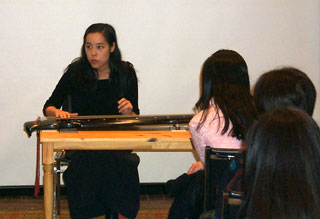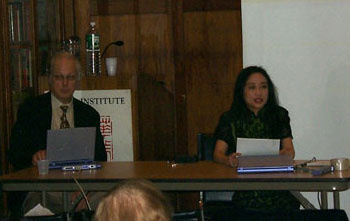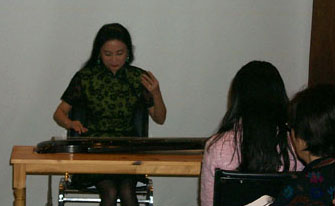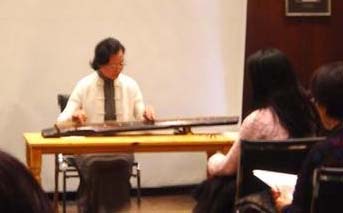| |
 Main Menu
Main Menu
選 項
Year 2000
Year 2001
Year 2002
Year 2003
| |
New York Qin Society Second Annual Conference
GUQIN MUSIC: PEOPLE, POETRY AND PLACE
Date: 23 November 2002
Time: 1:00-5:00PM
Place: China Institute of America, 125 East 65th Street
Program/Performance Notes
Bo LAWERGREN
“Qin 101” 琴 一零一 (lecture)
Bo LAWERGREN, introduced the guqin, an instrument different from any in the West or East, and speak about its physical nature and earliest history.
He will use pictures of ancient and extant instruments to document the gradual change of
the qin between 500 B.C. to 500 A.D.
勞 鎛先生將廣泛的從不同方面介紹古琴樂器 包括與琴有關的自然物理及早期的歷史記載 他將使用古代樂器的照片和現存的樂器 顯示從紀元前五百年到紀元後五百年間的古琴變化
Peiyou CHANG
Innocent Seagulls (Ou Lu Wang ji) 鷗鷺忘機

|
Innocent Seagulls (Ou Lu Wang ji)
鷗鷺忘機 performance by Peiyou CHANG. The present tune Ou Lu Wang Ji was composed in the
eighteenth century of the Qing dynasty (1644-1911). There is an earlier tune "Wang-Ji" that
was composed by the qin master Liu Zhifang of the Song dynasty (960-1279). These two tunes
are different, but both are based on a fable from the “Huangdi” chapter of the book of
Liezi: There was an old fisherman who sailed the ocean. The seagulls were so used to him
that they flew close enough for him to pet them. Once his wife noticed this and asked him, " Why don't you bring one or two seagulls home with you, so that I can also enjoy them?" The next day, the fisherman went back to his boat to catch some seagulls. But somehow, as soon as he made a move to do so, the seagulls soared higher and higher and never come down to him as before. The moral of this story is that opportunism can be sensed by others, and if we do not harbor such thoughts, we can live in harmony with nature and others. This story is also recorded in the qin handbook Wu Zhi Zhai Qin Pu (1721), where it praises the importance of a pure heart and intentions.
Ms. CHANG learned this piece herself from the Qin Notebook of the Wu School (1998), edited
by Wu Zhaoji who transcribed the piece according to the qin handbook Zi Yuan Tang of 1802.
張培幼女士演奏曲目 “鷗鷺忘機” 是自學自師祖吳兆基先生主持之【吳門琴譜】(1998) 吳先生所彈是
根據【自遠堂琴譜】(成於1802) 此曲是根據【列子】黃帝中的一則故事之寓意作成 故事原文如下:有
海翁者 常遊海上 群鳥習而狎焉 其妻知之 抵暮還家 謂翁曰 鷗鳥可娛 盍攜一二歸玩之 至旦往 則群鷗
高飛不下矣【五知齋琴譜】(成於1721年)的後記中對此曲有解題:海日朝暉 滄江夕照 群鳥眾和
翱翔自得 此曲所要表達之意境除了描述海鳥飛翔海空 混然忘機之自然景色外 也在于讚美一種純善之
心 不存害人利己之念 這個世界才會自然和諧
Mingmei YIP
“Mountain, Palace, Temple and Private Chamber—Qin Music and its Setting”
山林 宮廷 廟院及私家庭館----琴的音樂及其所在的環境(lecture)

|
Mingmei YIP discussed the musical environment of the zither as one of the four
arts -- weiqi (encirclement chess), painting and calligraphy. Playing the qin has long
been a refined pastime for intellectuals, and qin-players included not only men of
letters (wenren ), but also Buddhist and Daoist monks, as well as women, both high born
(guixiu, who mostly performed at home) and those of other classes, such as courtesans.
Depending on the setting, playing the qin could be for entertainment, religious devotion
and self-cultivation. In modern times, the qin has usually been performed in a setting
unlike any in earlier Chinese history – the concert hall.
葉明媚女士討論中國文化中四藝(琴棋書畫)裏的琴 古琴的音樂環境 彈琴這件事 長久以來被公認為是中華文化的精粹
彈琴的人不祇限於文人 還包括和尚道士 或者一般女性和大家閨秀 並廣及各個階層 妓女也不例外
彈琴可以在娛樂或宗教中使用 也可以使用為個人的修身養性 現代古琴則是多半用來表演的
尤其是在音樂廳中的演奏 這已不同於過去的歷史
Mingmei YIP
Chant of Buddhist Priest Pu An (Pu’an Zhou) 普庵咒
Three Variations on a Plum Blossom Theme (Meihua san nong; 1744) 梅花三弄

|
Chant of Buddhist Priest Pu An (Pu’an Zhou) 普庵咒 performance by Mingmei YIP.
The earliest extant notation of this famous chant is found in the Sanjiao Tongsheng
Qinpu (1592) with the alternate title “Shitanzhang;” it also included a Sanskrit text.
This version of the incantation was transmitted by Master Shen Caonong through Tsai
Teh-yun and is taken from Xuzhai Qinpu, a handbook compiled recently by Zhuang Jiancheng;
it does not have a Sanskrit text accompanying it.
葉明媚女士所演奏的普庵咒為沈草農傳 蔡德允女士授自近代莊劍承之【栩齋琴譜】初刊于明本
【三教同聲琴譜】 (1592) 原名【釋談章】內附梵語曲辭 起首曰: 南無普庵祖師菩薩 末段又云:
普庵到此百無禁忌 其後流傳發展 分成【釋談章】及【普庵咒】兩曲 原註云: 此佛曲也 琴譜流傳有二
一有辭即普庵禪師之咒語 一無辭專寫鐘磬銚鈸唱讚之聲 聽之不啻魚山聞梵 今所奏者是也
Three Variations on a Plum Blossom Theme (Meihua san nong; 1744) 梅花三弄performance by
Mingmei YIP. This piece is the version learned from Master Tsai Teh-yun (born 1905) taught
to her by her teacher Shen Caonong (1891-1972). Based on the notation from the handbook
Chuncaotang Qinpu (1744), the theme was originally a celebrated melody for flute associated
with the musician Huan Yi of the Jin dynasty (266-420). Later arranged for solo qin in the
Tang dynasty (618-907), it has became a favorite of qin players. The “variations” refer
to the three times the original theme is played in harmonics.
葉明媚女士演奏的梅花三弄亦為沈草農傳 蔡德允女士所授自【春草堂琴譜 】(1744) 原為笛曲晉代桓伊
以吹是曲知名 後經唐人改編為琴曲 又名梅花引 詠寫梅花高潔清幽的風致 三弄 原指笛吹有三弄之調
入於琴曲 則指曲中的泛音樂段出現三次 取泛音音色之清爽飄逸 並有重複對襯的效果
Marilyn Wong GLEYSTEEN
Three Variations on a Plum Blossom Theme (Old Version); Meihua san nong [Lao Mei] 梅花三弄(老梅花)

|
Meihua san nong [Lao Mei] 梅花三弄(老梅花) performance by Marilyn Wong GLEYSTEEN.
This piece is a musical ode to the blossoming plum, which, along with the pine and bamboo,
is known in Chinese painting and poetry as the “Three Friends of Winter.” With snow still
covering the ground, the plum is the first to bloom in the chill of late winter, a tribute
to its stalwart spirit and vigor. There are a number of poetic lines that are associated
with each section of the piece, assisting the performer and listener to visualize the plum
imagery in its natural setting. The two opening chords vividly suggest the bright moon
rising above the hills. The wintry beauty of the delicate blossom is evoked by the
appearance in harmonics of the first variation. This lively melody is repeated two
more times in different registers, evoking the varied aspects of this noble blossom.
The second theme and development follows in a livelier tempo with a complexity that
suggests the vigor and texture of the trunk and branches. The plum blossom blooms from
new shoots growing from an old trunk; this is seen traditionally as analogous to the hardy
spirit of the scholar.
This is the first piece she learned from her teacher Yuan Jung-ping, who learned it from
his teacher Wu Zhaoji (1908-1997). It was first published in the early Ming dynasty
Handbook of Miraculous Mysteries [Shen Qi Mi Pu, 1425] and was originally a tune for
the Xiao vertical flute dating from the fourth century; it was later adapted for guqin
in the eighth century by Tang master Yan Shigu. This version is also known as “
Old Plum Blossom.” It differs from the more embellished version found in the Chun Cao
Tang qin handbook of 1744, and she chose to play it to follow the Mingmei YIP’s
performance, so that the listener may compare the two versions.
王妙蓮女士演奏的這是一首贊頌梅花的曲子 梅松竹在中國畫與詩中 被稱為[歲寒三友]
當雪還覆蓋著大地時 梅花在寒冬裏第一個開花 象徵其堅毅的風骨 琴譜中每段樂曲都有附詩
可幫助演奏者想像梅花所處於大自然中的畫面 此曲一開始的兩個開放和音代表著月亮出現於山邊
第一段表現梅花寒冷細膩而和諧的美感 輕快的旋律在不同的音域重復兩次以上 表現出梅花高貴面貌
第二主旋律及其發展 是採用稍快的速度 表達樹幹質感及樹枝多樣的姿態 以呈現出梅花的精神
老幹出新枝 傳統中常借著贊嘆梅花 而與人的堅毅精神連在一起 這是王妙蓮女士向袁中平先生所學的
第一首琴曲 他是從吳兆基先生學來的 此曲初刊印於明朝初年的[神奇秘譜]中 此曲於八世紀時唐朝的
顏師古 跟據四世紀時簫的曲調而改編成為琴曲的 此版本被稱為”老梅花”是不同於1744年[春草堂
琴譜]中所刊印的同名曲 她選擇在葉明媚之後演奏 就是為了便於聽者比較兩種不同的版本
Intermission
to page 2.“Qin Players of Yore and their Lore”
to page 3. Speakers and Performers
|

